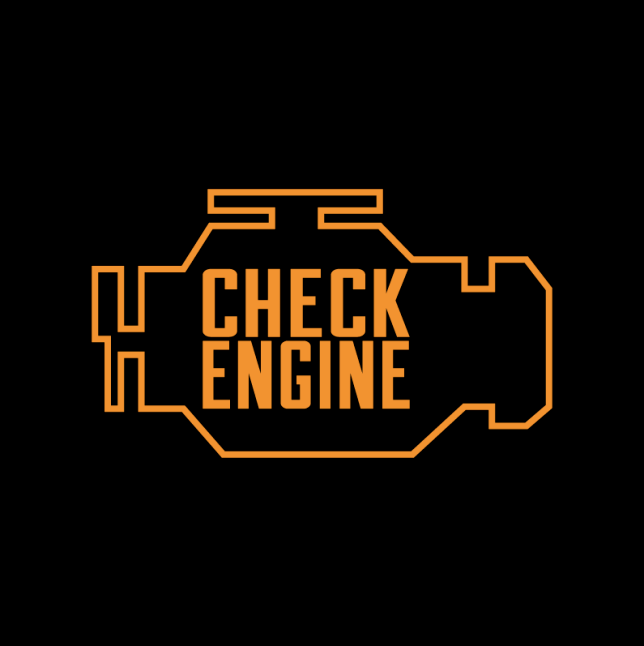The “check engine” or “service engine soon” light is a very important part of your vehicle’s performance, dependability and capability for lowering emissions.
Early vehicles required a tune-up every 5,000 to 15,000 miles. But tuning a vehicle made in the last 20 years is just not done anymore. It’s a “past” term.
Tuning a vehicle used to be like being the conductor of an orchestra, making sure that each and every instrument was played at the correct instant, right volume and length of time -- timing being critical. In the tuning of engines, it was making sure that every cylinder was doing its part, and that the spark of each spark plug was delivered at precisely the correct time with the proper intensity.
Checking all this on a scope – firing times, voltage potential, fuel delivery -- was a very difficult job. Few knew how to do it thoroughly.
The modern vehicle is an incredible piece of equipment, and is the most advanced technology that people own. Millions of lines of code are written; very advanced control units make all the “tuning” choices quickly and accurately for all driving and temperature conditions.
Now here’s the good and great news with a little bad news.
Modern cars deliver great performance and good fuel mileage with very little maintenance. (Spark plugs every 105,000 miles vs. every 5,000 in older vehicles). Modern vehicles are even able to tell you when something is not correct. If the feedback to the control unit is out of parameters, that is when the “check engine” light comes on. It’s like having an onboard mechanic (or doctor) always checking to see if everything is OK.
In 2016, the second most common repair for the light coming on also was the most expensive, a catalytic convertor. The average cost for that repair is around $1,200.
 Now here is the golden nugget: The most common reason a catalytic convertor goes bad is human procrastination, not getting the “check engine” light fixed soon after it comes on. An improperly running engine puts off an imbalance of air/fuel mixture that overworks the catalytic convertor, causing it to fail.
Now here is the golden nugget: The most common reason a catalytic convertor goes bad is human procrastination, not getting the “check engine” light fixed soon after it comes on. An improperly running engine puts off an imbalance of air/fuel mixture that overworks the catalytic convertor, causing it to fail.
According to CarMD, the most common “check engine” light repairs are around $250-$350.
Drive with it on too long, and you add another $1,200. Sounds like a no brainer to me; get it fixed soon.
Now to the next part of diagnosing and repairing “check engine” lights.
Often, we have a vehicle come in with multiple codes present. For the sake of integrity and cost, we repair only what we feel is the most common and prevalent code first, clear the codes and test-drive the vehicle. If the light does not come back on, we will release it to the customer and inform him or her that if the light comes back on, we will rescan for free and do more repairs if necessary. The reason for waiting is simple: One sensor or problem can affect other sensors into reading outside the parameters, causing the light to come on.
Reading, diagnosing and repairing the “check engine” light is the most challenging repair we have in our shops. Having the enhanced (factory) scanner is imperative to doing the job properly.
This is an area where getting it fixed soon is wise. The good news is that, dollar for dollar, a newer engine takes less maintenance and costs less than an older engine.
When do you need brakes?
One of the concerns we have at our shops is people bringing in their vehicle for new brakes when it’s not necessary.
New brakes start out at 100 percent of what we call the lining or thickness of the brake pad (disc brakes) or brake shoe (drum brakes). Every time you use the brakes, you take off a very small percentage of this lining.
We estimate the life of your brakes in percentages. Even when lining is down to 20 percent, your brakes are working 100 percent. I perceive a fear: “Only 20 percent? Wow, I must get my brakes replaced.”
Not true. Even brakes with 10 percent left are 100 percent safe. Sometimes we even hear stories that your brakes MUST be replaced now or they will not work. This is very seldom true or almost never if it’s about brake lining. We do recommend replacing brake lining at 10 percent to err on safety. The moral of this story: Sometimes it’s a good idea to get a second opinion.
Tips
Never leave any living animals in a vehicle with the windows rolled up. On a hot sunny day, temperatures can rapidly increase to above 135 degrees. Leave the animals at home; it’s a matter of life and death for them.
When getting into a hot car after it has been sitting in the sun, roll down the windows for the first three minutes of driving. I have measured the temperature of a closed-up vehicle, and it was over 135 degrees. Rolling the windows down will expedite the cooling process.
Questions or comments are more than welcome. Email me at [email protected]